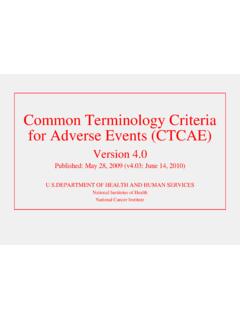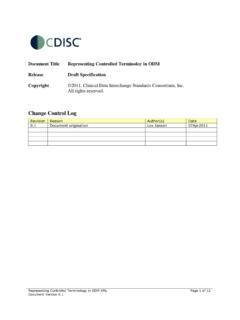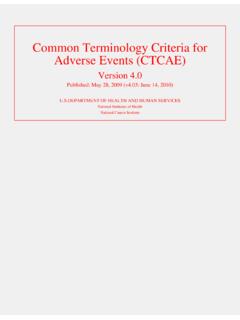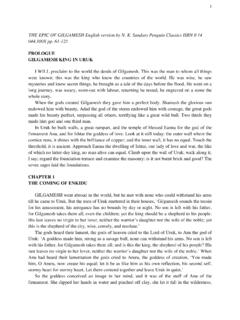Transcription of Common Terminology Criteria for Adverse Events (CTCAE)
1 1. CTCAE Common Terminology Criteria for Adverse Events (CTCAE). version OF HEALTH AND HUMAN SERVICES. National Institutes of Health National Cancer Institute Common Terminology Criteria for Adverse Events (CTCAE). Publish Date: May 28, 2009. Quick Reference Definitions Not all Grades are appropriate for all AEs. The NCI Common Terminology Criteria for A brief definition is provided to clarify the Therefore, some AEs are listed with fewer than Adverse Events is a descriptive Terminology which meaning of each AE term. five options for Grade selection. can be utilized for Adverse Event (AE) reporting. Grade 5. A grading (severity) scale is provided for each AE Grades term. Grade refers to the severity of the AE. The CTCAE Grade 5 (Death) is not appropriate for some AEs displays Grades 1 through 5 with unique clinical and therefore is not an option. Components and Organization descriptions of severity for each AE based on this Activities of Daily Living (ADL). SOC general guideline: *Instrumental ADL refer to preparing meals, System Organ Class, the highest level of the Grade 1 Mild; asymptomatic or mild shopping for groceries or clothes, using the MedDRA hierarchy, is identified by anatomical or symptoms; clinical or diagnostic telephone, managing money, etc.
2 Physiological system, etiology, or purpose ( , observations only; intervention not SOC Investigations for laboratory test results). indicated. **Self care ADL refer to bathing, dressing and CTCAE terms are grouped by MedDRA Primary Grade 2 Moderate; minimal, local or undressing, feeding self, using the toilet, taking SOCs. Within each SOC, AEs are listed and noninvasive intervention indicated; medications, and not bedridden. accompanied by descriptions of severity (Grade). limiting age-appropriate CTCAE Terms instrumental ADL*. Grade 3 Severe or medically significant but An Adverse Event (AE) is any unfavorable and not immediately life-threatening;. unintended sign (including an abnormal hospitalization or prolongation of laboratory finding), symptom, or disease hospitalization indicated; disabling;. temporally associated with the use of a medical limiting self care ADL**. treatment or procedure that may or may not be considered related to the medical treatment or Grade 4 Life-threatening consequences.
3 Procedure. An AE is a term that is a unique urgent intervention indicated. representation of a specific event used for Grade 5 Death related to AE. medical documentation and scientific analyses. Each CTCAE term is a MedDRA LLT (Lowest A Semi-colon indicates or' within the description Level Term). of the grade. A single dash (-) indicates a grade is not available. _____. CTCAE incorporates certain elements of the MedDRA Terminology . For further details on MedDRA refer to the MedDRA MSSO Web site ( ). 2. Blood and lymphatic system disorders Blood and lymphatic system disorders Grade Adverse Event 1 2 3 4 5. Anemia Hemoglobin (Hgb) <LLN - Hgb < - g/dL; < - Hgb < - g/dL; < - Life-threatening consequences; Death g/dL; <LLN - mmol/L; <LLN - mmol/L; <100 - 80g/L mmol/L; <80 - 65 g/L; urgent intervention indicated 100 g/L transfusion indicated Definition: A disorder characterized by an reduction in the amount of hemoglobin in 100 ml of blood. Signs and symptoms of anemia may include pallor of the skin and mucous membranes, shortness of breath, palpitations of the heart, soft systolic murmurs, lethargy, and fatigability.
4 Bone marrow hypocellular Mildly hypocellular or <=25% Moderately hypocellular or >25 - Severely hypocellular or >50 - Aplastic persistent for longer Death reduction from normal cellularity <50% reduction from normal <=75% reduction cellularity from than 2 weeks for age cellularity for age normal for age Definition: A disorder characterized by the inability of the bone marrow to produce hematopoietic elements. Disseminated intravascular - Laboratory findings with no Laboratory findings and Life-threatening consequences; Death coagulation bleeding bleeding urgent intervention indicated Definition: A disorder characterized by systemic pathological activation of blood clotting mechanisms which results in clot formation throughout the body. There is an increase in the risk of hemorrhage as the body is depleted of platelets and coagulation factors. Febrile neutropenia - - Present Life-threatening consequences; Death urgent intervention indicated Definition: A disorder characterized by a decrease in neutrophils associated with fever.
5 Hemolysis Laboratory evidence of Evidence of hemolysis and >=2 Transfusion or medical Life-threatening consequences; Death hemolysis only ( , direct gm decrease in hemoglobin, no intervention indicated ( , urgent intervention indicated antiglobulin test; DAT; Coombs'; transfusion steroids). schistocytes; decreased haptoglobin). Definition: A disorder characterized by laboratory test results that indicate widespread erythrocyte cell membrane destruction. Hemolytic uremic syndrome Evidence of RBC destruction - Laboratory findings with clinical Life-threatening consequences, Death (schistocytosis) without clinical consequences ( , renal ( , CNS hemorrhage or consequences insufficiency, petechiae) thrombosis/embolism or renal failure). Definition: A disorder characterized by a form of thrombotic microangiopathy with renal failure, hemolytic anemia, and severe thrombocytopenia. Leukocytosis - - >100,000/mm3 Clinical manifestations of Death leucostasis; urgent intervention indicated Definition: A disorder characterized by laboratory test results that indicate an increased number of white blood cells in the blood.
6 Lymph node pain Mild pain Moderate pain; limiting Severe pain; limiting self care - - instrumental ADL ADL. Definition: A disorder characterized by a sensation of marked discomfort in a lymph node. Spleen disorder Incidental findings ( , Howell- Prophylactic antibiotics - Life-threatening consequences; Death Jolly bodies); mild degree of indicated urgent intervention indicated thrombocytosis and leukocytosis Definition: A disorder of the spleen. Thrombotic thrombocytopenic Evidence of RBC destruction - Laboratory findings with clinical Life-threatening consequences, Death purpura (schistocytosis) without clinical consequences ( , renal ( , CNS hemorrhage or consequences insufficiency, petechiae) thrombosis/embolism or renal failure). Definition: A disorder characterized by the presence of microangiopathic hemolytic anemia, thrombocytopenic purpura, fever, renal abnormalities and neurological abnormalities such as seizures, hemiplegia, and visual disturbances.
7 It is an acute or subacute condition. Blood and lymphatic system Asymptomatic or mild Moderate; minimal, local or Severe or medically significant Life-threatening consequences; Death disorders - Other, specify symptoms; clinical or diagnostic noninvasive intervention but not immediately life- urgent intervention indicated observations only; intervention indicated; limiting age- threatening; hospitalization or not indicated appropriate instrumental ADL prolongation of existing hospitalization indicated;. disabling; limiting self care ADL. CTCAE - May 28, 2009 : Blood and lymphatic system disorders 3. 3. Cardiac disorders Cardiac disorders Grade Adverse Event 1 2 3 4 5. Acute coronary syndrome - Symptomatic, progressive Symptomatic, unstable angina Symptomatic, unstable angina Death angina; cardiac enzymes and/or acute myocardial and/or acute myocardial normal; hemodynamically stable infarction, cardiac enzymes infarction, cardiac enzymes abnormal, hemodynamically abnormal, hemodynamically stable unstable Definition: A disorder characterized by signs and symptoms related to acute ischemia of the myocardium secondary to coronary artery disease.
8 The clinical presentation covers a spectrum of heart diseases from unstable angina to myocardial infarction. Aortic valve disease Asymptomatic valvular Asymptomatic; moderate Symptomatic; severe Life-threatening consequences; Death thickening with or without mild regurgitation or stenosis by regurgitation or stenosis by urgent intervention indicated valvular regurgitation or imaging imaging; symptoms controlled ( , valve replacement, stenosis by imaging with medical intervention valvuloplasty). Definition: A disorder characterized by a defect in aortic valve function or structure. Asystole Periods of asystole; non-urgent - - Life-threatening consequences; Death medical management indicated urgent intervention indicated Definition: A disorder characterized by a dysrhythmia without cardiac electrical activity. Typically, this is accompanied by cessation of the pumping function of the heart. Atrial fibrillation Asymptomatic, intervention not Non-urgent medical intervention Symptomatic and incompletely Life-threatening consequences; Death indicated indicated controlled medically, or urgent intervention indicated controlled with device ( , pacemaker), or ablation Definition: A disorder characterized by a dysrhythmia without discernible P waves and an irregular ventricular response due to multiple reentry circuits.
9 The rhythm disturbance originates above the ventricles. Atrial flutter Asymptomatic, intervention not Non-urgent medical intervention Symptomatic and incompletely Life-threatening consequences; Death indicated indicated controlled medically, or urgent intervention indicated controlled with device ( , pacemaker), or ablation Definition: A disorder characterized by a dysrhythmia with organized rhythmic atrial contractions with a rate of 200-300 beats per minute. The rhythm disturbance originates in the atria. Atrioventricular block complete - Non-urgent intervention Symptomatic and incompletely Life-threatening consequences; Death indicated controlled medically, or urgent intervention indicated controlled with device ( , pacemaker). Definition: A disorder characterized by a dysrhythmia with complete failure of atrial electrical impulse conduction through the AV node to the ventricles. Atrioventricular block first Asymptomatic, intervention not Non-urgent intervention - - - degree indicated indicated Definition: A disorder characterized by a dysrhythmia with a delay in the time required for the conduction of an electrical impulse through the atrioventricular (AV) node beyond seconds; prolongation of the PR interval greater than 200 milliseconds.
10 Cardiac arrest - - - Life-threatening consequences; Death urgent intervention indicated Definition: A disorder characterized by cessation of the pumping function of the heart. Chest pain - cardiac Mild pain Moderate pain; limiting Pain at rest; limiting self care - - instrumental ADL ADL. Definition: A disorder characterized by substernal discomfort due to insufficient myocardial oxygenation. Conduction disorder Mild symptoms; intervention not Moderate symptoms Severe symptoms; intervention Life-threatening consequences; Death indicated indicated urgent intervention indicated Definition: A disorder characterized by pathological irregularities in the cardiac conduction system. Constrictive pericarditis - - Symptomatic heart failure or Refractory heart failure or other Death other cardiac symptoms, poorly controlled cardiac responsive to intervention symptoms Definition: A disorder characterized by a thickened and fibrotic pericardial sac; these fibrotic changes impede normal myocardial function by restricting myocardial muscle action.





